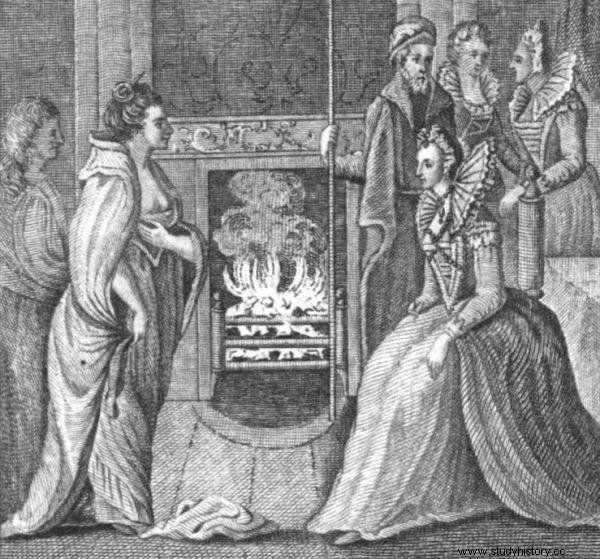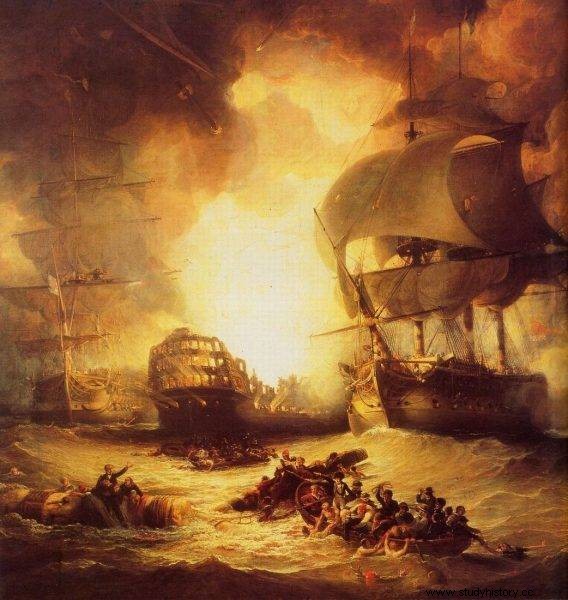For centuries, the presence of ladies at sea was considered a misfortune, although the ancients wrote that in the event of a storm, a naked woman, exposing herself to the wind, could ... calm the storm. Nevertheless, there were many women on the ships. Though not always of their own free will.
The common opinion was that the fair sex was considered too weak to wander at sea, excessively fearful and prone to hysteria, and in addition demoralizing men. And yet - despite many superstitions and prohibitions - women stayed on ships in various roles. Sometimes in accordance with their own role, often against it. They tied their fate with the sea and men of all professions who set out on it.
If he were to fight like a man ...
The world of pirates was a male world - just like the world of business, art and politics at that time. Women who wanted to conquer him had to adopt a male way of being, think and behave, as well as show entrepreneurship, courage and ruthlessness. A perfect example of this (from the era preceding the golden age of piracy) was Grace O'Malley (c. 1530–1603), known by the Irish as Gráinne Ní Mháille (Granuaile). This is what Angus Konstam writes about her in the book Świat piratów :
Her father, the head of the Ní Mháille clan or O'Malley, was the lord of the long coastline in what is now County Mayo and levied a tax on fishermen fishing in nearby waters. In 1546 Gráinne married Donal O'Flaherty of a noble lineage who dealt with petty piracy. […]
The widow continued her husband's craft; She resided in her father's fortress on Clare Island, on the west coast of Mayo. On the orders of a concerned local administration, she was arrested in 1577 (after the siege of the fortress), but later released from prison. Her children were held hostage. She went to London; received an audience with Elizabeth I, and as a result - freeing the branches. The aging pirate queen practiced her vile, albeit hopeless, activity to her death.

Grace O'Malley during an audience with Queen Elizabeth I.
Gráinne Ní Mháille, which even had a few monographs on itself, was one of the few cases of a career of the fair sex in the industry:throughout the seventeenth and eighteenth centuries, piracy remained the domain of masters. The female vocation was to be home, kitchen and childbearing, not shipping, robbery and fighting. This is probably why the contemporary society was so shocked by the presence of two women - Anne Bonny and Mary Read in the crew of John "Calico Jack" Rackam.
The story of two fearless pirates who sneak into a closed community of pirates in male disguises, making themselves famous vulgar, valiant and cruel , even today it intrigues and wonders. Both ladies seemed to be comfortable in their role, as Bonny made a contemptuous comment during the execution of her lover:"If he fought like a man, he wouldn't have to hang like a dog."
They must be given pirate honor, because they owed their fame only to their own qualities, and in spite of many adversities, they gained the freedom to decide about themselves and their lives under the pirate flag. They have become a symbol of victory over the limitations of their era and shedding the shackles of "female" social roles. And while it's hard to say if they had any pirate aspirations or dreams, they failed to do great things in their profession. In contrast to Zheng Shi, who lived more than half a century later, also known as Madame Zheng, who successfully continued the legacy of her husband, commander of the Red Flag Fleet in 1807. As we read in Świat piratów :
The pirate power was ruled by a woman who traditionally first caught the attention of the great Zheng as a prostitute in Guangzhou. She has proven to have an innate managerial talent . She showed competence and stubbornness, gained recognition, and in a few years she expanded the Red Flag to the sizeable 800 junks. For a period of three years, it completely dominated the coastal zone from Hainan to Formosa.
Determined and fearless, Madame Zheng felt no respect towards anyone - she did not hesitate to kidnap the British for ransom, which her husband would never have gone so far as to do. In September 1809, she captured seven sailors from a British East India Company ship anchored outside Guangzhou. One of the prisoners, Richard Glasspole, described the laws of Madame Zheng as follows:“Theft, disobedience, and rape were punishable by death; minor offenses, for example desertion - cutting off an ear, thumb, even the whole arm or leg ”. Discipline and discipline were the key to keeping order.
Madame Zheng's career ended after three years. After exhausting fights with the imperial fleet, she acknowledged her defeat and accepted pardon. With a small amount of force, she withdrew to Guangdong, where she found another market niche where she could pursue her entrepreneurial talents. For the next three decades, she ran the largest opium smuggling on the Chinese coast.
Baba? Goods like any other!
Some researchers call the buccaneer community (the predecessors of the "golden age" pirates) chauvinists, for whom femininity meant nothing but weakness and failure. The tough sea wolves of the Renaissance or the Enlightenment saw the fair sex as suitable only for carnal pleasures , usually short-lived, as mentioned by the authors of the monograph devoted to pirates:“Their opinion about women did not differ from that of other invaders. For the buccaneers, women were a commodity that could be plundered, traded or shared with comrades-in-arms. "
The famous Henry Morgan "blamed the harlots for the poverty in which his people lived," although he spent every moment on land in his youth either in a tavern or in a brothel. Before he was fifty (which was a record for a pirate anyway), he developed gout, cirrhosis of the liver and atherosclerosis. In the last year of his life, which he ended as the governor of Jamaica, he was under the constant care of a doctor who wrote about the old terrors of the seas:“thin, sallow skin, yellowed eyes, bloated stomach, he complained of a lack of appetite for food; had nausea or vomiting every morning and general dizziness. ”

The text was created, among others based on the book by Angus Konstam “Świat piratów. The history of the most dangerous sea robbers ”, which has just been released by the Bellona publishing house.
Few women have managed to follow in the footsteps of the legendary pirates and realize their dreams of a career at sea - the most common links between piracy and the fate of a woman were violence and prostitution. Both in first-hand accounts, letters and diaries, as well as period books, led by Captain Johnson's General History ... first published in 1724, it is teeming with human trafficking, kidnappings and rapes, which were part of the pirate trade.
So we can read about the Caribbean Coast of Mosquitoes, where every pirate used to buy a woman for a knife or an ax from the locals, about the Pearl Coast of Panama, from where pirates marauding the surrounding waters in the 17th century regularly kidnapped inhabitants to sell them to captivity, or about the Bocas del Toro Indians who stopped engaging in any business with buccaneers because they regularly enslaved their women.
According to one of the accounts, Edward England's crew "in an inhuman way forced women to satisfy their desires", and the crew of 21 Thomas Anstis, after taking some unfortunate woman into captivity, gang raped her, finally breaking her spine and throwing her into the sea . John Gow's sailors, in turn, captured two young girls who were "barbarously used".
Blackbeard - otherwise known to be unresponsive to violence - was accused of forcing his sixteen-year-old (fourteenth) wife into group sex with several of his crew. This is not true, as is the romantic story of the wedding of Henry Every, an English pirate in the second half of the 17th century, with a Mongolian princess.
Every was to discover on the hijacked ship the granddaughter of the emperor from the Great Mongol dynasty, whom he immediately asked for a hand and married - with her consent - in the Muslim rite. His people, in turn, married the princess's beautiful maidservants. Londoners could read such a version in 1709. The truth is slightly different - according to court documents and testimonies of witnesses, pirates stormed the ship and raped all the women there for several days. Several of them escaped their torturers, jumping into the sea to their death or stabbing themselves with a dagger.
Hell on board
Apart from a large group of pirate captives, port maids and "everlasting brides", wives also sailed on ships, mainly boatswain, and their role was by no means limited to sitting in a cabin. The ship was often their only home, and those whose husbands served in the navy spent many difficult years at sea.
There was strict discipline in the Royal Navy, but the presence of "hellish ballast" - be they wives or other female companions - was more common than many wished . Admiral John Mennes, inspector of the Royal Navy, complained in 1666 about the "plague of women on ships" and wrote that on the decks, instead of men's trousers, women's petticoats and skirts flapped. And the naval chaplain Henry Teonge described the scenes on the frigate "Assistance" in 1675:
Here many wives of our sailors follow them to the sea, and a few young women accompany their loved ones with a song Loath to depart on the lips, saying goodbye to them with punch and brandy. Our ship was full of supplies that night, but unmanned, for few were able to stand guard should the need arise. Someone might be surprised to see a couple crawling into a hammock or female legs hanging on its sides. Some lovers have fallen asleep on the chest, others, half-drunk, continue in hot kisses, sailors fall asleep in the arms of women who prefer to go out to sea with them and die there, rather than stay on land and live without them.

British seaman John Nicol wrote that during the naval battle of Abukir in August 1798, women on the "Goliath" frigate helped the ship's boys to carry gunpowder to the guns.
It is impossible to estimate how many sailors were married today, but we know that when the 76-gun "London" exploded in 1665, the wreckage of which still rests at the mouth of the Thames, about 300 men died in the accident, leaving 50 widows. Samuel Pepys noted several situations in which high-born officers took their lovers to sea, and one case when the king himself forbade Captain William Jenning to take his wife to the frigate, but she followed him on a merchant ship, and the husband did trips to it whenever possible.
Two hundred years later in the British Navy, some captains and at least one admiral (intransigent in this respect, the famous Vice Admiral Cuthbert Collinwood) continued to forbid the presence of women on their ships, but the regulation itself and life itself . In the regulations of the frigate "Indefatigable" from 1812 you can find separate regulations for "women members of the ship's crew."
It is difficult to say whether they concerned only the wives of officers and sailors, but we know that those ladies who went out to sea often became invaluable help to the crew, for example, accompanying the surgeon at work or helping with daily duties (although they were not included in the inventory). seamen and were not paid). British seaman John Nicol wrote that during the naval battle of Abukir in August 1798, women on the "Goliath" frigate helped the ship's boys to carry gunpowder to the guns:
Women showed courage and self-sacrifice equal to men, and received an award for bravery. […] I am indebted to the gunner's wife who brought us wine from time to time, encouraging us and encouraging us to fight. Some were wounded in battle, one died, and we buried her on a small island in the bay. One of the women gave birth to a son during the fighting.
Although childbirth accompanied by rumbling cannons, a running crew and exploding gunpowder had to be a borderline experience, in the age of long sea voyages, children were also born on ships. Even reluctant to see women aboard, Admiral Nelson became godfather to the baby born on the Minotaur in July 1800.
Twelve years later, in a sea battle, a sailor serving on a sloop and his wife were killed, orphaning a three-week-old baby. There was no other breastfeeding woman on board, but the baby was rescued by drinking it with the milk of the ship's goat.
When in 1847 the Medal of the General Maritime Service was awarded for service in naval conflicts and operations in the Royal Navy to all men (and only men), regardless of age, who could prove their presence, one of the few survivors to receive this award for the Battle of Uschant 1 June 1794, there was Daniel Mackenzie of Tremendous. His name and rank are engraved on the medal:"Daniel T. Mackenzie - Baby - H.M.S. Tremendous. "
How many ladies faithfully stood by the combatants and died alongside their men? it is not known. We do know that only two centuries later, in 1993, Great Britain followed in the footsteps of other countries and equated women serving in the Royal Navy with men in rights and privileges.
Bibliography:
- Klausmann, U., Meinzerin, M., Kuhn, G., Women Pirates and the Politics of the Jolly Roger , Montreal 1997.
- Konstam, A., The world of pirates. The history of the most dangerous sea robbers , Bellona 2020.
- Kuhn, G., Life Under the Jolly Roger:Reflections on Golden Age Piracy , Chicago 2010.
- Little, B., The Golden Age of Pirates, trans. M. Studencki, Krakow 2017.
- Rodger, N.A.M., The Command of the Ocean. A Naval History of Britain 1649–1815 , London 2004.
- Stark, S. J., Female Tars:Women Aboard Ship in the Age of Sail , London 1996.
- Turley, H., Rum, sodomy, and the lash:piracy, sexuality, and masculine identity , New York 1999.
- Woodard, C., The Pirate Republic, trans. B. Czartoryski, Krakow 2014.
